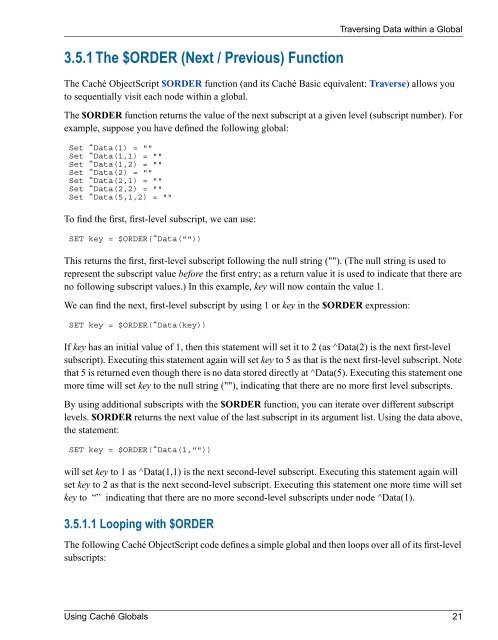Using Caché Globals - InterSystems Documentation
Using Caché Globals - InterSystems Documentation
Using Caché Globals - InterSystems Documentation
Create successful ePaper yourself
Turn your PDF publications into a flip-book with our unique Google optimized e-Paper software.
3.5.1 The $ORDER (Next / Previous) FunctionThe <strong>Caché</strong> ObjectScript $ORDER function (and its <strong>Caché</strong> Basic equivalent: Traverse) allows youto sequentially visit each node within a global.The $ORDER function returns the value of the next subscript at a given level (subscript number). Forexample, suppose you have defined the following global:Set ^Data(1) = ""Set ^Data(1,1) = ""Set ^Data(1,2) = ""Set ^Data(2) = ""Set ^Data(2,1) = ""Set ^Data(2,2) = ""Set ^Data(5,1,2) = ""To find the first, first-level subscript, we can use:SET key = $ORDER(^Data(""))This returns the first, first-level subscript following the null string (""). (The null string is used torepresent the subscript value before the first entry; as a return value it is used to indicate that there areno following subscript values.) In this example, key will now contain the value 1.We can find the next, first-level subscript by using 1 or key in the $ORDER expression:SET key = $ORDER(^Data(key))If key has an initial value of 1, then this statement will set it to 2 (as ^Data(2) is the next first-levelsubscript). Executing this statement again will set key to 5 as that is the next first-level subscript. Notethat 5 is returned even though there is no data stored directly at ^Data(5). Executing this statement onemore time will set key to the null string (""), indicating that there are no more first level subscripts.By using additional subscripts with the $ORDER function, you can iterate over different subscriptlevels. $ORDER returns the next value of the last subscript in its argument list. <strong>Using</strong> the data above,the statement:SET key = $ORDER(^Data(1,""))will set key to 1 as ^Data(1,1) is the next second-level subscript. Executing this statement again willset key to 2 as that is the next second-level subscript. Executing this statement one more time will setkey to “” indicating that there are no more second-level subscripts under node ^Data(1).3.5.1.1 Looping with $ORDERTraversing Data within a GlobalThe following <strong>Caché</strong> ObjectScript code defines a simple global and then loops over all of its first-levelsubscripts:<strong>Using</strong> <strong>Caché</strong> <strong>Globals</strong> 21

















